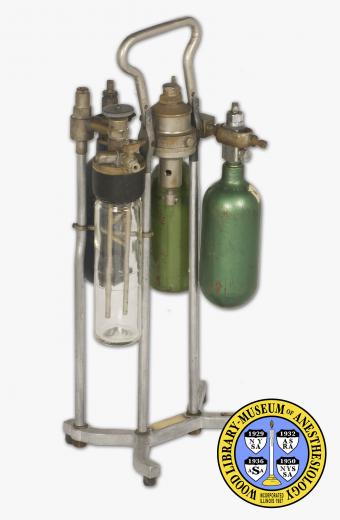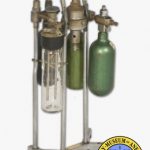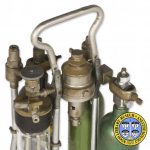Gwathmey & Woolsey Apparatus
The Gwathmey-Woolsey Nitrous Oxide-Oxygen Apparatus was developed to administer ether as well as nitrous oxide and oxygen. Introduced in 1912, its design was partially rooted in guidelines for nitrous oxide-oxygen anesthesia recommended by physicians Frederic Cotton (1869-1938) and Walter Boothby (1880-1953), designers of the Cotton-Boothby Apparatus. The most notable similarity between this apparatus and the Cotton-Boothby is the water-sight flowmeter, or ‘bubble bottle,’ which was first developed to estimate the rate of flow for both nitrous oxide and oxygen.
Dr. William Cavan Woolsey (1876-1919) and Dr. James Tayloe Gwathmey (1862-1944) worked as anesthetists in New York City. Dr. Gwathmey was a dynamic and talented physician whose extraordinary career profoundly impacted the profession of anesthesiology. Gwathmey was among the first American private-practice anesthesiologists and one of the very first to contend that anesthesiology was the practice of medicine. Gwathmey invented and modified a wide range of anesthesia devices, and he was a founding member of the New York Society of Anesthetists, a precursor of the American Society of Anesthesiologists. He also wrote the first comprehensive American textbook on the subject of anesthesia.
Catalog Record: Gwathmey & Woolsey Apparatus
Access Key: aiwm
Accession No.: IL 1940-2
Title: [Gwathmey-Woolsey nitrous oxide-oxygen apparatus / designed by James T. Gwathmey and William C. Woolsey.]
Author: Gwathmey, James Tayloe, 1862-1944.
Author: Woolsey, William C. (Cavan).
Title variation: Alt Title
Title: Gwathmey and Woolsey Apparatus.
Title variation: Alt Title
Title: Gwathmey Woolsey nitrous oxid-oxygen apparatus.
Title variation: Alt Title
Title: Gwathmey-Woolsey gas-oxygen apparatus.
Title variation: Alt Title
Title: Gwathmey Woolsey nitrous oxide and oxygen apparatus.
Publisher: New York : Foregger Co., [1914-1920].
Physical Description: 1 anesthesia machine : brass, other metals, glass ; 55 x 24 x 20 cm.
Subject: Anesthesia Machines.
Subject: Anesthesia, Inhalation.
Subject: Nitrous Oxide.
Subject: Oxygen.
Subject: Ether, Ethyl.
Note Type: General
Notes: Alternate titles from Gwathmey’s 1914 text, Anesthesia.
Note Type: Citation
Notes: Foregger R. Gwathmey. Anesthesiology. 1944;5(3):296-299.
Note Type: Citation
Notes: Gwathmey JT. Anesthesia. New York: D. Appleton & Co., 1914:170-174.
Note Type: Citation
Notes: Gwathmey JT. The three-table military operating room: a plan applicable to
civil hospitals. Ann Surg. 1919;70(40):497-502.
Note Type: Physical Description
Notes: One anesthesia apparatus; The base is approximately the shape of two letters
“Y” with the terminals placed end to end; Two metal plates are affixed to the
base; The first metal plate is marked with, “THE FOREGGER COMPANY INC. [new
line] MEDICAL OXYGEN APPLIANCES [new line] NEW YORK”; The second metal plate
is smaller than the first and is marked with, “GWATHMEY”; The functional
parts of the apparatus are attached to, and held aloft by, three vertical
supports; There are three yokes for small nitrous oxide and oxygen tanks, a
central reducing valve for nitrous oxide, a regulating valve for nitrous
oxide, and a regulating valve for oxygen; Below the two regulating valves,
protruding into a clear glass bottle, are two metal tubes; Through one tube
nitrous oxide would flow, and through the other tube oxygen would flow; A
handle to carry the device is attached to the top of two of the vertical
supports.
Note Type: Reproduction
Notes: Photographed by Mr. William Lyle, September 23, 2010; In order to present an
image of the apparatus in the best state possible, it was photographed with
generic gas tanks (or cylinders) from the Parts Collection.
Note Type: Historical
Notes: This device was developed to administer nitrous oxide and oxygen, as well as
ether if desired. Introduced in 1912 and originally spelled,
“Gwathmey-Woolsey Nitrous Oxid-Oxygen Apparatus” (“oxid” rather than
“oxide”), its design was partially rooted in guidelines for nitrous
oxide-oxygen anesthesia recommended by physicians Frederic Cotton (1869-1938)
and Walter Boothby (1880-1953), designers of the Cotton-Boothby Apparatus
(Gwathmey, 1914). The most notable similarity between the Gwathmey-Woolsey
and the Cotton-Boothby is the water-sight flowmeter, or ‘bubble bottle’,
which was first developed by Cotton and Boothby to estimate the rate of flow
for both nitrous oxide and oxygen. The Gwathmey-Woolsey apparatus was the
precursor to the Gwathmey Apparatus. The manufacturer, The Foregger Co., began
operations in 1914, in Roslyn, Long Island, New York.
Note Type: Historical
Notes: Dr. James Tayloe Gwathmey (1862-1944) was a dynamic and talented physician
who’s extraordinary career profoundly impacted the profession of
anesthesiology. The following are but a few of Gwathmey’s great number of
accomplishments. He was among the first American private-practice
anesthesiologists and one of the very first to contend that anesthesiology
was the practice of medicine. He wrote the first comprehensive American
textbook on the subject of anesthesia. He was also ahead of his time in his
interest to improve operating room management. He invented and modified a
wide range of anesthesia devices, and he was a founding member of the New
York Society of Anesthetists, a precursor of the American Society of
Anesthesiologists.



